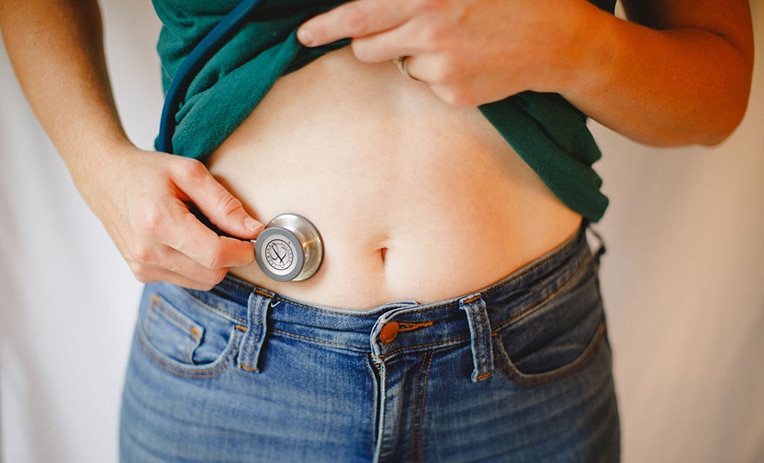Have you ever started a new routine with incredible energy and motivation – only to have it fizzle out after a week or two?
Maybe you tried a new exercise program and felt confident and refreshed, only to feel stressed out and depressed all of a sudden.
I know I have. It felt like these sudden changes came out of nowhere. And it left me confused and frustrated, like I was all over the place all the time.

But what if I told you there was a way to schedule your life so you could be more productive and less stressed? And that it involved aligning your lifestyle to your hormonal patterns?
In this article, I’ll introduce the practice of cycle syncing and discuss how it can affect many aspects of your life. You’ll also learn natural ways to support your body throughout your menstrual cycle.
First, let’s talk about the reason we need cycle syncing in the first place – our infradian rhythm.
The Times of Our Lives: What Is Infradian Rhythm?
Chances are you’re already familiar with circadian rhythm, your internal biological clock that mimics the earth’s day-night cycle and lasts about 24 hours. Your sleep-wake patterns are an example of circadian rhythms. These alternating patterns also affect other important functions in your body, such as your hormone release, eating habits and digestion, and body temperature.1
But your body has another time keeper – the infradian rhythm.
Unlike circadian rhythm, infradian rhythms are longer than 24 hours but shorter than 1 year.2 The most cited example of an infradian rhythm is the human menstrual cycle, which takes about 28 to 32 days to complete.3 Other examples of infradian rhythm are seasonal affective disorder, molting, and hibernation.
Your infradian rhythm affects more than your menstrual cycle though. It can also influence:
- Your mood
- Your immune system
- Your stress response system
- Your metabolism
- Your microbiome
- Your reproductive system
This means that your energy level, mood, nutritional needs, and so much more can be fairly predictable by tuning into the ebb and flow of your hormones. Once you determine your particular rhythm, you can coordinate your lifestyle and routines to be more energy-efficient.
The Infradian Rhythm and Your Menstrual Cycle
“That time of the month” is really a misconception.
Your menstrual cycle isn’t an isolated time that generally occurs for a few days every month. Rather, your period is only the first in a cycle of four phases that are constantly rotating over the course of approximately 28 days.
Let’s go through each phase.
Phase 1: Menstrual Phase
It’s impossible to ignore the menstrual phase of your cycle because of its key sign — your period.
Your menstrual phase starts when a sperm doesn’t fertilize the egg from your previous cycle, meaning a pregnancy doesn’t occur. As a result, your uterus sheds its thickened inner lining, which exits from your body in a combination of tissue, mucus, and a little bit of blood. On average, the menstrual phase lasts between 3 and 7 days.4
This is also when your estrogen and progesterone levels drop. You might feel more inclined to stay home and Netflix or take a nap (or two). Listen to your body. Now may not be the best time to try out a new intense workout.
Some women may also experience symptoms like:
- Abdominal cramps
- Mood swings
- Bloating
- Tender breasts
- Headaches
- Tiredness
- Low back pain
- Sensitive skin
Phase 2: Follicular Phase
The follicular phase starts on the first day of your menstrual cycle, so there’s some overlap with the menstrual phase. But instead of ending with your period, the follicular phase lasts about 2 weeks.
The breakdown of the corpus luteum and decreases in estrogen and progesterone levels at the end of the previous menstrual cycle trigger a positive feedback to the hypothalamus and anterior pituitary gland in your brain. This results in the release of gonadotropin-releasing hormone (GnRH), which then stimulates the secretion of FSH into circulation.5
The increase in FSH level encourages a certain type of cell in your ovaries – granulosa cells – to recruit follicles (small sac-like structures) from each ovary. As the follicles mature, estradiol levels rise in response to the increased FSH levels. This increase results in a negative feedback that leads to a decrease in FSH levels.6
It’s also at this time the “dominant follicle” is determined. While all follicles undergo maturation, only the dominant follicle goes through the next phase of the menstrual cycle, ovulation. The other follicles are suppressed and undergo a degenerative process called atresia.
Towards the end of the follicular phase, the rapid increase in estradiol levels results in the release of luteinizing hormones (LH), which signals the beginning of ovulation.
In addition to follicle maturation, changes are occurring in your endometrium. Some people refer to the follicular phase as the “proliferative phase” for this reason. The increasing estradiol levels leads to thickening of your endometrium in preparation to receive a fertilized egg.
During the follicular phase, you may:
- Feel more energized
- Be in a better mood
- Have a greater sex drive
- Have improved stamina
- Experienced better brain function
Phase 3: Ovulatory Phase
The ovulatory phase occurs in the middle of your cycle, around day 14. Everything that happened during the follicular phase was in preparation for ovulation.
The dramatic surge in LH at the end of the follicular phase triggers the release of an egg from the dominant follicle in the ovary, down the fallopian tube, and into the uterus. You can get pregnant at any time during this phase, so be mindful!
This phase of the menstrual cycle tends to be the shortest, lasting about 3 to 4 days. It’s also when your hormone levels are at their peak, so don’t be surprised if you feel more frisky or can go all out in your workouts. This is a great time to take on new projects with high confidence.
Phase 4: Luteal Phase
The luteal phase is the final phase of your menstrual cycle and lasts between 10 to 14 days, ending just before the start of the next menstrual cycle. During this phase, both LH and FSH decrease, and the follicle from which the egg was released transforms into a structure called the corpus luteum.
The corpus luteum secretes high levels of progesterone, which does the following:7
- It maintains the uterine lining, which has thickened courtesy of estrogen. The lining is filled with fluids and nutrients in preparation of a potential embryo (if fertilization of an egg has occurred).
- It causes the cervical mucus to thicken and become stickier, thereby preventing sperm and bacteria from entering the uterus.
- It raises the basal body temperature by about 0.5 degrees to 1 degree Fahrenheit.8 Your basal body temperature (BBT) is the lowest natural body temperature recorded after a period of rest, like when you wake up in the morning. The rise in BBT is sustained until the start of the next menstruation, at which point it returns to baseline.
If the egg becomes fertilized, the embryo will produce human chorionic gonadotropin, or hCG. This hormone promotes the production of progesterone by the corpus luteum to maintain the pregnancy. HCG can be detected in urine and serum about 2 weeks following implantation, though serum testing is more specific and sensitive. Measuring hCG levels can also help identify whether you have a normal pregnancy or a pathologic pregnancy.9
If the egg doesn’t become fertilized, progesterone levels will fall and the corpus luteum degenerates in about 14 days. At that time, your brain sends out a signal to prepare the next batch of follicles for ovulation, starting the menstrual cycle again.
Estrogen levels hold steady at a high level throughout most of the luteal phase, though its levels and that of progesterone decrease if a fertilized egg doesn’t implant. This means that you may feel or experience the following, many of which are symptoms of premenstrual syndrome (PMS):
- Breast tenderness or swelling
- Less energy (towards the end of the phase)
- More focused (earlier on in the phase)
- Need to eat more
- Higher resting cortisol levels
- Headaches
- Mood changes
- Bloating
- Weight gain
- Difficulty sleeping
What is Cycle Syncing?
In the past, you may not have spent much time thinking about your biological patterns. After all, many (if not most) people are only aware of one biological clock, the circadian rhythm.
But as you’ve learned above, our bodies and brains undergo significant changes during each phase of our menstrual cycles. This means our exercise, diet, and self-care should vary with each phase, too.
This is the core concept behind cycle syncing, the practice of adjusting aspects of your life based on the phase of your menstrual cycle. Introduced by integrative nutritionist and women’s health expert Alisa Vitti, cycle syncing aims to help balance hormones and reduce hormonal symptoms.
The Benefits of Cycle Syncing
You might be asking, “Why should I center my life around my period?”
It might seem like yet another thing to keep in mind – and who has time for that?
Our society places heavy emphasis on habits. Going to work from nine to five. Eating the same thing for lunch. Working out at 5 PM after work. And repeat. We’re encouraged to live off a 24-hour cycle.
That might work for men, whose hormone levels don’t fluctuate widely throughout the month. But for women, keeping the same routine day in and day out can mean working against the natural rhythm of your hormones.
Take exercise for example.
During the menstrual phase and the latter half of the luteal phase, your energy levels are likely to be low. Honor these phases by making time for low-impact workouts like gentle yoga or walking.
Cycle syncing can also help if you have:
- Polycystic ovarian syndrome (PCOS)
- PMS symptoms
- Low libido
- Irregular menstrual cycles
- Difficulty getting pregnant
- Difficulty losing weight
Simply put, the better you listen to the messages your body is telling you, the easier it’ll be to give it what it needs.
How to Get Started With Cycle Syncing
1. Track your cycle.
The first step to cycle syncing is to start tracking your cycle. Remember, your body is unique. While I gave the average lengths of each phase above, the length of yours may be different. Download an app like Natural Cycles to start tracking.
2. Keep a journal.
Record in detail how you feel at different points in your cycle. You can also experiment with different eating patterns or physical exercises to see how they impact you.
Let’s look at the luteal phase as an example.
During the latter half of the phase, you’ll likely feel the desire to spend more time at home. This is a time to nurture, slow down, and rest. It’s also a great time to support detoxification pathways to metabolize and eliminate excess hormones produced during earlier phases.
Research has also documented reductions in insulin sensitivity during the luteal phase.10,11 Unfortunately, this is also the time when women tend to increase their caloric and/or carbohydrate intake, which is thought to be driven by high progesterone levels.12 Try foods like leafy greens and root vegetables that can help curb your cravings.
Frequently Asked Questions About Cycle Syncing
Because cycle syncing is still such a new concept to many, I wanted to answer some questions I get asked most frequently.
Can Cycle Syncing Help Balance My Hormones?
It can be a tool in your toolbox. By matching your diet and workouts to the phase of the menstrual cycle you’re in, you could help keep your insulin, progesterone, and cortisol levels more balanced.
How Can I Sync My Food/Exercise/Supplements and Mindbody Practices With My Cycle?
Keep a journal and use a cycle tracking app. Make it a ritual to note the things you do and foods you eat, and observe how they impact how you feel.
You may find lists of foods you should eat and exercises you should do during each phase of the cycle. Rather than sticking with strict lists, I encourage you to use the concept of cycle syncing to your advantage and gain a whole new level of awareness about your body. It can truly become your superpower!
When Should I Practice Intermittent Fasting?
In general, I recommend you avoid fasting during the luteal phase of your cycle. Because your body is preparing itself for a possible pregnancy, this is the time to provide more nutrition for your body, not less. You may also be more sensitive to stress during this phase, so I recommend minimizing stress as much as possible.
Fasting can be better tolerated during the follicular phase for some women.
You can read more about my recommendations for intermittent fasting here.
What Supplements Can I Use to Support My Cycle?
Biphasic herbal formulas can help harmonize the various hormones in your body and maintain a regular menstrual cycle. I recommend two herbal formulas — one formula for the first half of the cycle (ending with ovulation), and another for the latter half of the cycle (ending with the start of menstruation).
Can Syncing My Cycle Help With My Symptoms of Acne, Fatigue, Weight Gain, and PMS?
It can. Many of these symptoms can be attributed to hormonal imbalance. By becoming more aware of what your body needs and making the necessary changes, you may find that your symptoms either reduce in severity or are eliminated.
Cycle Syncing is a Path to Body Literacy
Remember, the goal of cycle syncing isn’t to be perfect, eating the right foods and doing the right exercises at precisely the right time.
It’s more about figuring out how to work with your body and not against it, learning what makes your body feel good and what doesn’t. All you need to do is listen.
If you want more guidance on understanding your menstrual cycle and hormones, download my comprehensive guide, Know Your Cycle. In it, you’ll find more helpful tips on things you should keep track of and healthy recipes to help support hormonal balance.
Women’s Hormone Specialist in Boston
I know all of this information can be overwhelming at first. But as a women’s health expert, I can’t emphasize enough how important it is for all women to listen to our bodies.
If you feel that hormonal imbalance could be the root cause of your health problems, schedule a free 15-minute consultation with me today to start your journey towards a healthier, happier you.
I consult with women nationwide through telehealth, so whether you’re in the Boston area, on the opposite coast, or somewhere in between, I’m ready to help.
Schedule a free 15-minute consultation today to learn more about how I can help you.
References:
- https://nigms.nih.gov/education/fact-sheets/Pages/circadian-rhythms.aspx
- https://www.sciencedirect.com/science/article/pii/B9780128012383037946
- https://www.sciencedirect.com/science/article/pii/B9780128137765000029
- https://my.clevelandclinic.org/health/articles/10132-menstrual-cycle
- https://www.ncbi.nlm.nih.gov/books/NBK542229/
- https://www.ncbi.nlm.nih.gov/books/NBK542229/
- https://www.merckmanuals.com/home/women-s-health-issues/biology-of-the-female-reproductive-system/menstrual-cycle
- https://www.ncbi.nlm.nih.gov/books/NBK546686/
- https://www.ncbi.nlm.nih.gov/books/NBK532950/
- https://www.ncbi.nlm.nih.gov/pmc/articles/PMC2999972/?report=reader
- https://pubmed.ncbi.nlm.nih.gov/1997519/
- https://pubmed.ncbi.nlm.nih.gov/7985630/




